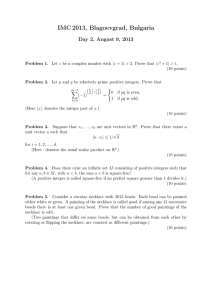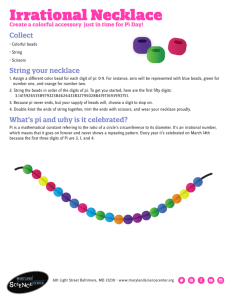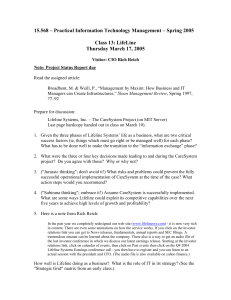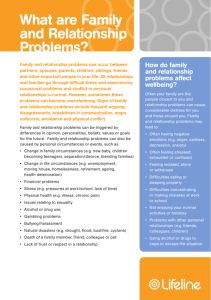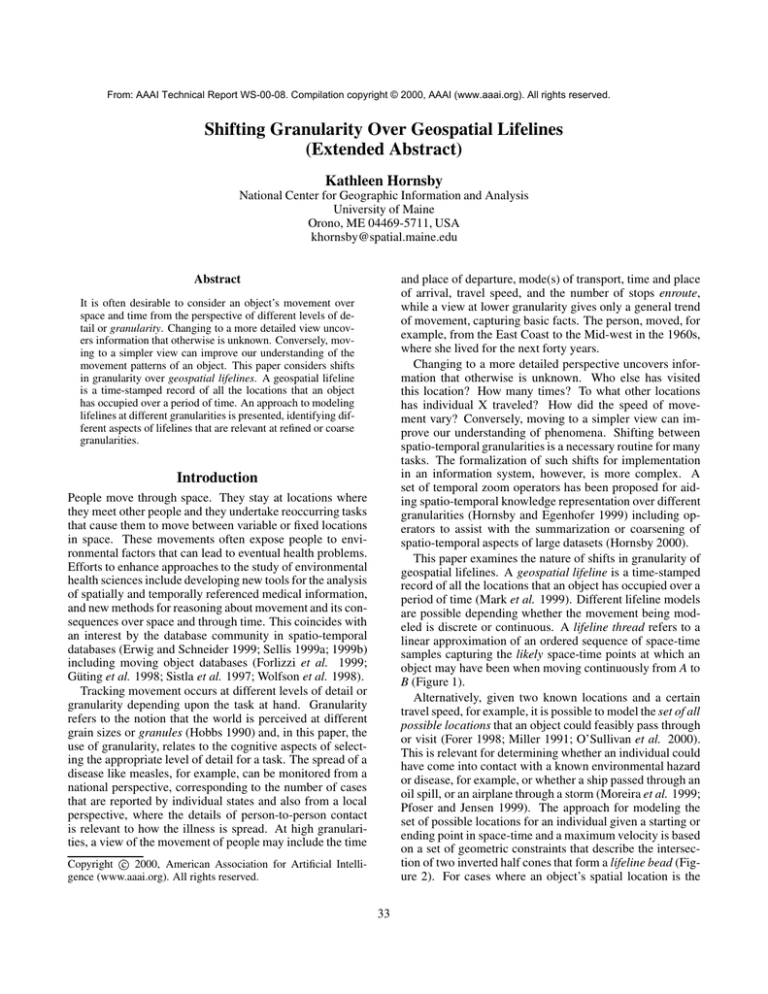
From: AAAI Technical Report WS-00-08. Compilation copyright © 2000, AAAI (www.aaai.org). All rights reserved.
Shifting Granularity Over Geospatial Lifelines
(Extended Abstract)
Kathleen Hornsby
National Center for Geographic Information and Analysis
University of Maine
Orono, ME 04469-5711, USA
khornsby@spatial.maine.edu
Abstract
and place of departure, mode(s) of transport, time and place
of arrival, travel speed, and the number of stops enroute,
while a view at lower granularity gives only a general trend
of movement, capturing basic facts. The person, moved, for
example, from the East Coast to the Mid-west in the 1960s,
where she lived for the next forty years.
Changing to a more detailed perspective uncovers information that otherwise is unknown. Who else has visited
this location? How many times? To what other locations
has individual X traveled? How did the speed of movement vary? Conversely, moving to a simpler view can improve our understanding of phenomena. Shifting between
spatio-temporal granularities is a necessary routine for many
tasks. The formalization of such shifts for implementation
in an information system, however, is more complex. A
set of temporal zoom operators has been proposed for aiding spatio-temporal knowledge representation over different
granularities (Hornsby and Egenhofer 1999) including operators to assist with the summarization or coarsening of
spatio-temporal aspects of large datasets (Hornsby 2000).
This paper examines the nature of shifts in granularity of
geospatial lifelines. A geospatial lifeline is a time-stamped
record of all the locations that an object has occupied over a
period of time (Mark et al. 1999). Different lifeline models
are possible depending whether the movement being modeled is discrete or continuous. A lifeline thread refers to a
linear approximation of an ordered sequence of space-time
samples capturing the likely space-time points at which an
object may have been when moving continuously from A to
B (Figure 1).
Alternatively, given two known locations and a certain
travel speed, for example, it is possible to model the set of all
possible locations that an object could feasibly pass through
or visit (Forer 1998; Miller 1991; O’Sullivan et al. 2000).
This is relevant for determining whether an individual could
have come into contact with a known environmental hazard
or disease, for example, or whether a ship passed through an
oil spill, or an airplane through a storm (Moreira et al. 1999;
Pfoser and Jensen 1999). The approach for modeling the
set of possible locations for an individual given a starting or
ending point in space-time and a maximum velocity is based
on a set of geometric constraints that describe the intersection of two inverted half cones that form a lifeline bead (Figure 2). For cases where an object’s spatial location is the
It is often desirable to consider an object’s movement over
space and time from the perspective of different levels of detail or granularity. Changing to a more detailed view uncovers information that otherwise is unknown. Conversely, moving to a simpler view can improve our understanding of the
movement patterns of an object. This paper considers shifts
in granularity over geospatial lifelines. A geospatial lifeline
is a time-stamped record of all the locations that an object
has occupied over a period of time. An approach to modeling
lifelines at different granularities is presented, identifying different aspects of lifelines that are relevant at refined or coarse
granularities.
Introduction
People move through space. They stay at locations where
they meet other people and they undertake reoccurring tasks
that cause them to move between variable or fixed locations
in space. These movements often expose people to environmental factors that can lead to eventual health problems.
Efforts to enhance approaches to the study of environmental
health sciences include developing new tools for the analysis
of spatially and temporally referenced medical information,
and new methods for reasoning about movement and its consequences over space and through time. This coincides with
an interest by the database community in spatio-temporal
databases (Erwig and Schneider 1999; Sellis 1999a; 1999b)
including moving object databases (Forlizzi et al. 1999;
Güting et al. 1998; Sistla et al. 1997; Wolfson et al. 1998).
Tracking movement occurs at different levels of detail or
granularity depending upon the task at hand. Granularity
refers to the notion that the world is perceived at different
grain sizes or granules (Hobbs 1990) and, in this paper, the
use of granularity, relates to the cognitive aspects of selecting the appropriate level of detail for a task. The spread of a
disease like measles, for example, can be monitored from a
national perspective, corresponding to the number of cases
that are reported by individual states and also from a local
perspective, where the details of person-to-person contact
is relevant to how the illness is spread. At high granularities, a view of the movement of people may include the time
Copyright c 2000, American Association for Artificial Intelligence (www.aaai.org). All rights reserved.
33
Time
create other views of a lifeline thread returns a sequence of
lifeline beads forming a lifeline necklace such that the end
point of one bead is the start point of the next bead (Figure 3). This sequence of beads traces an object’s movement
in space and time at a higher granularity, revealing more detail about the path of movement.
Y
Lifeline
Thread
Space
X
Figure 1: Lifeline thread.
Time
y
same at two space-time samples, the set of possible locations forms a right bead (intersecting right half cones). All
other cases result in an oblique bead based on intersecting
oblique half cones. The area of intersection of two oblique
half cones is projected onto the x y axes as an ellipse.
x
Figure 3: Movement can be modeled as a sequence of lifeline beads that form a lifeline necklace.
x1 ,y 1 ,t 1
Upper
Half
Cone
Lower
Half
Cone
Time
y
Space
Lifeline
Bead
x0 ,y 0 ,t 0
Space
Refining granularity results in:
expanded temporal detail such that more timesteps are relevant,
additional locations through which the object passed become known, and
more detail about the speed of movement between locations becomes known.
Now, at a higher granularity, portions of the movement
may be revealed to be at slower speeds, such as corresponding to periods when the individual was in heavy traffic perhaps, or portions at faster speeds, as when traveling on a
highway. More detail about the travel path becomes known
through the addition of spatial information, revealing unknown or unexpected side trips. Perhaps the individual visited a location more than once. The varying lengths of individual beads corresponding to time spent on each segment
of movement also yields useful information, for example,
whether it is possible for the individual to have participated
in certain activities or not.
x
Figure 2: Lifeline beads based on all possible locations for
an individual given a starting (x0 ,y 0 ,t0 ) and ending point
(x1 ,y 1 ,t1 ) in space time and given a maximum velocity.
Granularity of Lifelines
A higher granularity returns a new, more-detailed view of
an object’s movements between two locations. Lower granularities correspond to less-detailed views. Views here are
not defined as visual representations, but rather are refinements (i.e., more detailed views) or abstractions (less detailed views) of beads. All lifeline threads and beads have
multiple views, each of them distinct from the others. Each
view corresponds to a different way of perceiving movement
over space and time.
Coarsening Granularity
Coarsening granularity returns a new, less-detailed view of
an object’s movement. This type of operation is particularly
relevant to very large databases with detailed geospatial lifeline data. Very long lifeline necklaces may require abstraction into simpler, generalized views.
Abstracting lifeline beads results in:
Refining Granularity
An object’s movement can be modeled as a single lifeline
thread. At a higher granularity, the movement between two
of the known locations along a thread, can be modeled as a
bead, capturing more detail about the possible locations that
the object passed through. Refining granularity further to
34
coarsening temporal detail,
coarsening spatial detail, and
coarsening the detail relating to speed of movement.
Coarsening temporal detail occurs such that start and end
timestamps of all but the first and last beads in a lifeline
necklace are abstracted. Fewer timestamps are relevant to
this more general view of movement. Coarsening spatial
detail results in fewer start and end point locations being
modeled. Less detail is also maintained with respect to the
speed of movement.
Coarsening granularity occurs through aggregating 1 . . . n
lifeline beads into a generalized bead. In this way, the overall trend of movement is preserved with the start and end
point of a necklace forming the start and end points of the
generalized bead. Deriving generalized beads from lifeline
necklaces can be undertaken in at least two ways. Firstly,
a generalized bead is derived based on the start point and
end point location of a necklace together with the velocity
at the start and end points (Figure 4a). Secondly, a shapeapproximating approach based on the velocity at the start
and end points of the necklace as well as selected point locations chosen from the rim of particular beads in the necklace (Figure 4b) can be used to arrive at a generalized bead.
Depending on which rim points from the necklace are selected to influence the geometry of the composite bead, there
are many different solutions that can be computed with this
method.
Time
Time
y
Space
x
Figure 5: Coarser views of necklaces are obtained through
an approach based on convex hulls computed from the geometric properties of the necklace.
Conclusions
Rim
Point
Time
y
cations that an individual has visited. Coarser views of necklaces are also obtained through an approach based on convex
hulls computed from the geometric properties of the necklace (Figure 5). The tube structure resulting from the convex
hull approach is a coarser approximation of a lifeline necklace and, unlike the methods described above, it captures the
complete set of possible locations modeled by the necklace.
Spatio–temporal knowledge representation often requires
shifting from one granularity to another such that users can
carryout a desired task. This paper examines the effect of
shifting granularity with respect to geospatial lifelines. Depending on the desired granularity, varying views can be
modeled as lifeline threads, beads, necklaces, or tubular approximations based on the necklace and derived from convex hulls (Figure 6).
Refining granularity shifts the view from threads to beads
or from threads to necklaces, resulting in each case in a more
detailed view of movement. Coarsening granularity shifts
the view of movement from the details captured by lifeline
necklaces to the more general representations based on convex hulls and to the most general case of lifeline threads.
Shifting from beads to threads and from necklaces to beads
are also types of coarsening.
This paper has described some of the interesting aspects
relating to granularity of geospatial lifelines. Further work
is necessary on operations that move views between different granularities and especially relating to operations that result in coarser granularities of lifelines. The tubular approximations of necklaces and transformations from the tubes to
threads are among some of the interesting aspects that require further investigation.
y
Space
Space
x
(a)
x
(b)
Figure 4: Aggregations of 1 . . . n beads resulting in a generalized bead (a) based on the velocity and locations at the
start and end points of a lifeline necklace and (b) using selected point locations from the rim of certain beads to create
a generalized bead.
Both approaches have their shortcomings. Although attractive due to its simplicity, the first approach suffers from
being too coarse. Depending on the geometric properties of
the beads comprising the necklace, the set of all possible locations derived using this approach might be larger than the
set of locations actually described by the necklace. Additionally, parts of the necklace might lie outside of the generalized bead, resulting in possible locations being omitted
from the model.
Although the result may indeed be closer to the form of
the necklace, the second approach also is weakened by not
including parts of necklace beads in the generalized bead
(i.e., parts are outside of it). In certain circumstances, therefore, both approaches fall short of capturing all possible lo-
Acknowledgments
This work was partially supported by grants from the National Institute of Environmental Health Sciences, under
grant number 1 R 01 ES09816-01, the National Imagery
35
Italy, 487–491. Los Alamitos, CA: IEEE Computer Society.
Hornsby, K. 2000. Deriving summaries through an
identity-based approach. In Gonzalez, A., and Towhidnejad, M., eds., 13th International Florida AI Research Symposium Conference, FLAIRS’2000, (in press). Orlando,
FL: AAAI Press.
Mark, D., Egenhofer, M., Bian, L., Hornsby, K., Rogerson,
P., and Vena, J. 1999. Spatio-temporal GIS analysis for
environmental health using geospatial lifelines [abstract].
In Flahault, A., Toubiana, L., and Valleron, A., eds., 2nd
International Workshop on Geography and Medicine, GEOMED’99, 52. Paris, France: Inserm U444 WHO Collaborating Centre for Electronic Disease Surveillance.
Miller, H. 1991. Modelling accessibility using spacetime prism concepts within geographical information systems. International Journal of Geographical Information
Systems 5(3):287–301.
Moreira, J., Ribeiro, C., and Saglio, J.-M. 1999. Representation and manipulation of moving points: an extended
data model for location estimation. Cartography and Geographic Information Science 26(2):109–123.
O’Sullivan, D., Morrison, A., and Shearer, J. 2000. Using
desktop GIS for the investigation of accessibility by public
transport: an isochrone approach. International Journal of
Geographical Information Science 14(1):85–104.
Pfoser, D. and Jensen, C. 1999. Capturing the uncertainty
of moving-object representations. In Güting, R., Papadias,
D., and Lochovsky, F., eds., 6th International Symposium,
SSD’99, volume 1651 of Lecture Notes in Computer Science, 111–131. Hong Kong: Springer-Verlag.
Sellis, T. 1999a. Chorochronos: research on spatiotemporal database systems. In Tjoa, A., Cammelli, A., and
Wagner, R., eds., Proceedings of the 10th International
Workshop on Database and Expert Systems Applications,
DEXA’99, 452–456. Florence, Italy: IEEE Computer Society.
Sellis, T. 1999b. Research issues in spatio-temporal
database systems. In Güting, R., Papadias, D., and Lochovsky, F., eds., 6th International Symposium, SSD’99,
volume 1651 of Lecture Notes in Computer Science, 5–11.
Hong Kong, China: Springer-Verlag.
Sistla, A., Wolfson, O., Chamberlain, S., and Dao, S. 1997.
Modeling and querying moving objects. In Proceedings of
the Thirteenth International Conference on Data Engineering, ICDE13.
Wolfson, O., Xu, B., Chamberlain, S., and Jiang, L. 1998.
Moving objects databases: issues and solutions. In Proceedings of the 10th International Conference on Scientific
and Statistical Database Management, SSDBM’98, 111–
122.
Figure 6: Shifting granularity between a lifeline bead, a
necklace, a tubular approximation based on convex hulls,
and a lifeline thread.
and Mapping Agency under grant number NMA202-971-1023, and the National Science Foundation under grant
number SBR-9700465.
References
Erwig, M. and Schneider, M. 1999. Developments in
spatio-temporal query languages. In Tjoa, A., Cammelli,
A., and Wagner, R., eds., Proceedings of the 10th International Workshop on Database and Expert Systems Applications, DEXA’99, Florence, Italy, 441–449. Los Alamitos,
CA: IEEE Computer Society.
Forer, P. 1998. Geometric approaches to the nexus of time,
space, and microprocess: implementing a practical model
for mundane socio-spatial systems. In Egenhofer, M., and
Golledge, R., eds., Spatial and Temporal Reasoning in Geographic Information Systems. New York: Oxford University Press. 171–190.
Forlizzi, L., Güting, R., Nardelli, E., and Schneider, M.
1999. A data model and data structures for moving objects
databases. Technical Report 260 - 10/1999, Fern Universität, Hagen, Germany.
Güting, R., Böhlen, M., Erwig, M., Jensen, C., Lorentzos,
N., Schneider, M., and Vazirgiannis, M. 1998. A foundation for representing and querying moving objects. Technical Report 238 - 9/1998, Fern Universität, Hagen, Germany.
Hobbs, J. 1990. Granularity. In Weld, D., and de Kleer,
J., eds., Readings in Qualitative Reasoning about Physical
Systems. San Mateo, CA: Morgan Kaufmann Publishers,
Inc. 542–545.
Hornsby, K. and Egenhofer, M. 1999. Shifts in detail through temporal zooming. In Tjoa, A., Cammelli,
A., and Wagner, R., eds., Tenth International Workshop
on Database and Expert Systems Applications, Florence,
36


